By Pete Vack
Ok, why review a book about Porsches? 1. The Editor has always been smitten by early pre-911 Porsches, and we have covered other Porsche books herein. 2. The author of this particular book is Roy Smith, who has long been a supporter and contributor to VeloceToday. 3. Roy is also responsible for the multiple books on Renault racing, Gordinis and Alpines, and this is his third book on Porsche. We don’t know how he does it but his latest book certainly deserves a good send up!
Powered by Porsche, the alternative race cars, is bit different than the normal (or Super) Porsche book, in that it covers competition cars powered by Porsche engines, using up 458 pages to do so. What kind of ‘specials’ Roy would dig up was the interesting question. Obviously there were a lot!
The material is significant, and Smith uses first person accounts via exclusive interviews throughout the book to tell a very complex story. Says Roy, “For this book, I went Stuttgart to see and interview Herbert Linge, Hans Mezger, Valentin Schaeffer, Jürgen Barth, Norbert Singer in April 2016. In addition I have access to the full archives of Porsche and full support of the team there.”
This kind of approach will make Powered by Porsche an essential reference work both now and in the future. The scope spans more than 60 years of motor racing from the Cisitalia Porsche to the Fabcar Porsches in 2007, all with first person insights from the people involved. Herbert Linge was with Porsche from 1949, at the very birth of the marque and in addition, was sent to the States to assist importer Max Hoffman. Smith gets to Jurgen Barth, whose father Edgar began racing with Porsche in the 1950s, Porsche’s Norbert Singer and the ultimate Porsche specialist, Manfred Kremer. In addition, Smith has obtained help and contributions from many of the drivers, team managers, and designers for an impressive list far too long to mention here.
These are all race cars with independently constructed chassis powered by Porsche engines. It is also important to note here why there are so many Porsche powered racing chassis dating from the 1980s to today. Writes Smith in his Introduction: “In the late 1980s the demand for Porsche cars, chassis and parts outstripped the ability to deliver….this would lead to the creation of the ‘replicas’ as opposed to the factory built works race cars…in turn a whole new highly specialized high quality industry grew up to meet some of the demand for chassis tubs.” Smith lists and describes (in varying detail) 77 race cars (using their own chassis) powered by Porsche, and the vast majority of those 77 are dated from 1970 on. The years 1970-2010 constitute the bulk of the book (292 pages of 466), and while outside the realm of our expertise, are informative and interesting and have never been documented previously.
Please don’t forget to become a VeloceToday Premium Subscriber!
We note here that the book can only provide high level information on each of the cars listed; some tech details, a few race results, brief discussions with builders, drivers or owners. Some, like the Kremer Porsches, are of course worthy of a full book, others are rare one-offs that might have competed in only one event. The organization is by decades, which in this case makes sense.
1950s
For the 1950s, he finds some very interesting German specials made before the advent of the Porsche 550 Spyder including the six Glöckler Porsches whose success in Europe encouraged the factory to get on with developing their own Glöckler.
The Glöcklers themselves were very successful racers, and Smith quotes Herbert Linge who discussed his days working for Porsche and supporting Max Hoffman’s Glöckler racing car at the same time. Hoffman, it seems was very impatient and wanted a Porsche race car which did not yet exist so purchased the Glöckler number 2 and competed at Bridgehampton, Thompson and other SCCA venues, achieving a string of 1st and 2nd places which helped Hoffman sell a lot of Porsches (and VWs) from his New York dealership.
While in general Smith kept to competition cars, he included the twin supercharged Porsche created by bus king Louis Fageol, who raced the handful until he flipped it at Monterey and returned it to street form. He traces the multiple forms of the Coopers powered by Porsches, of which there were at least two, Lovely’s and Ken Miles’, but there may have been others though it is very hard to determine with any accuracy. He finds the Cooper Monaco stuffed with a four cammer for Jack McAfee, and suffice to say the Poopers were faster than the RS Porsches which led to greater things as one will see. Pete Lovely, with the assistance of Keck, (who helped Smith fill in the blanks) also built a ladder framed mid engined Porsche special called the “Porschewagen” which did well in the 1500cc class in 1954.
There may have been a dozen Porsche specials created for SCCA racing in the mid-1950s, but unless they achieved a placing in some race somewhere, their existence is hard to both imagine and prove. And in the entry lists, the car’s names are often misleading or confusing; the Poopers were listed at Cooper Mk8R in many programs. So finding all would be a difficult task. For example, Smith did not catch the Morlang Porsche, which was so ugly even if it had placed it would have been soon forgotten!
But he finds other treasures. How about a Gordini-Porsche, right up Roy’s alley. German born Kurt Delfosse migrates to Argentina in 1951, and later comes upon Gordini GC15 with no engine. Before long it sports a Porsche engine and new envelope body. Somehow Delfosse manages to install the Porsche engine, possibly a Carrera, into the rear of the front engined Gordini chassis. Why bother, one might wonder?
1960s
The success of the Cooper Porsches in the U.S. led to a greater use of English chassis in the 1960s, specifically the Elva Porsches, efforts which were aided and abetted by the Porsche factory who realized their own RSKs were too heavy. Here, Smith obtains the help from Jurgen Barth, whose father Edgar was a top Porsche racer in the sixties and helped develop the Elva Porsche for hillclimb use. Living in East Germany, Edgar Barth was racing in West Germany when he was told he should not return home for fear of punishment; Smith relates the families subsequent escape and employment at Porsche for son Jurgen.
Roy pays a bit of attention to the not strictly Porsche special Abarth Carrera, but uses the space to explain the Bobsy, Dolphin , Platypus and Lotus specials equipped with the still potent Carrera four. The decade also saw the development of the Porsche SOHC six as used in the 911 and spawned an entirely new generation of competition and street engines.
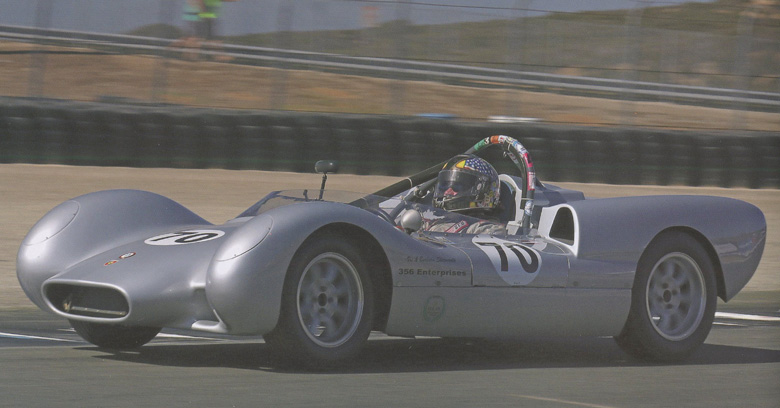
Ken Miles did well not only with his Pooper but in 1963 with the Otto Zipper-ordered Dolphin, aka Porphin.
But the heyday of Porsche Specials had yet to begin. While the term, Porsche Special, if ever seriously applied, was no longer used and often inferred amateur work, professional race teams and their shops began a thoroughly professional effort to use, modify and ultimately fabricate their own cars (often replicars) powered by Porsche.
1970s
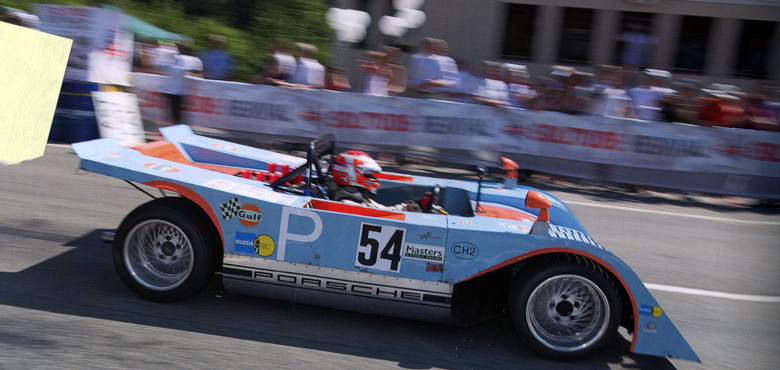
One of the last low bugdet Porsche powered sports racers was the Chanabe, a square tube frame car with a flat six Porsche engine that competed in the early 1970s.
By the 1970s the rear engine revolution Porsche had helped inspire was complete and every serious competition car was mid-engined. Porsche developed the flat 8 and at the same time, with even more fervor, the flat six. The decade kicked off with Porsche’s first Le Mans victory with the 917. The days of the independent garage innovator (like Miles) were over but there was a huge expansion of companies that could create race cars designed to use a variety of engines. Porsche became a favorite. One of the most successful was the Kremer team who reworked Porsche’s 934 and 935 so thoroughly that they became their own marque. The KMW- Porsche was designed to compete in the Sports Prototype class in Europe, as were a handful of other sports racers that fill the pages of the disco decade.
1980s to 2010
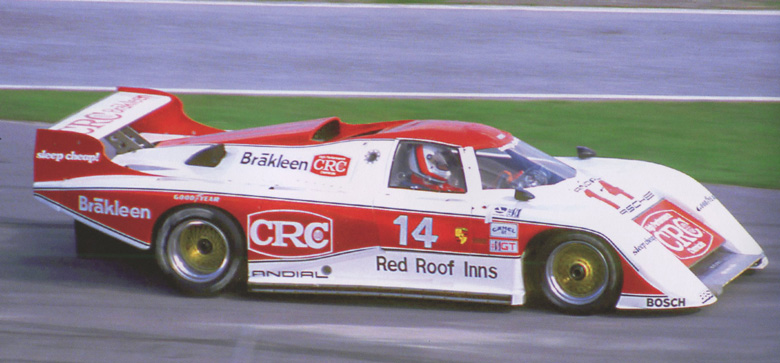
March was one constructor who used several different engines. The 83G had Chevy power to begin with but later it was powered by Porsche.
IMSA and the FIA introduced a number of class changes in the early 1980s which left the field wide open for even more small constructors to create chassis eligible for events on both sides of the water. Kremer continued to thrive, winning at Le Mans in 1979 with their 935 K3 and then made a 917 replica for the 1981 event, but it didn’t win. The introduction of the 959, 956 and 962 during the decades of the 1980s and 90s made things even more interesting, but the sports racing rules and classes became so confusing that even Porsche objected. The fact that the cars were now a complex combination of chassis, parts and motors meant that identication with a winner or particular make was ambiguous at best. In most cases, these cars were powered by some variation of the turbocharged flat six engine, in both sports prototype and GT classes.
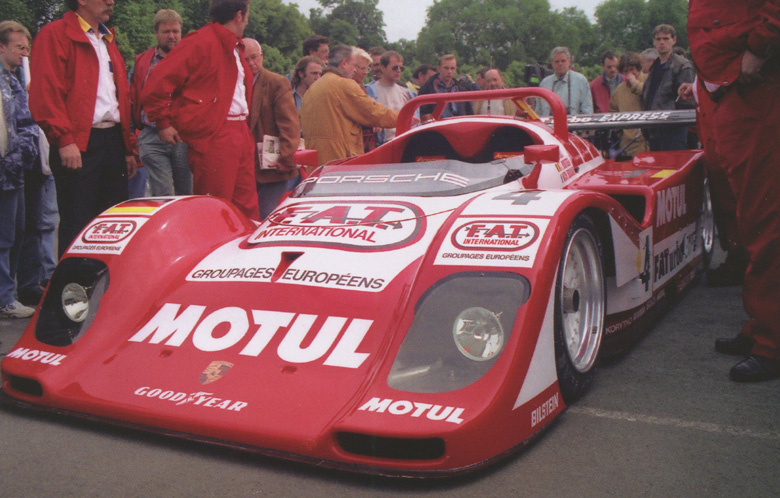
Le Mans, 1995. Kremer had been building its own Porsches for decades and continued to do so with this WSC Porsche-powered entry which placed 6th overall and second in class.
Smith takes us right up to 2010 as the classes became even more inscrutable. Fabcar Porsche ran both Toyota V8s and Porsche engines for U.S. race series, as did Crawford and Eddie Cheever racing. Smith goes bravely forward, talking in turn to many of the principals involved in the various teams.
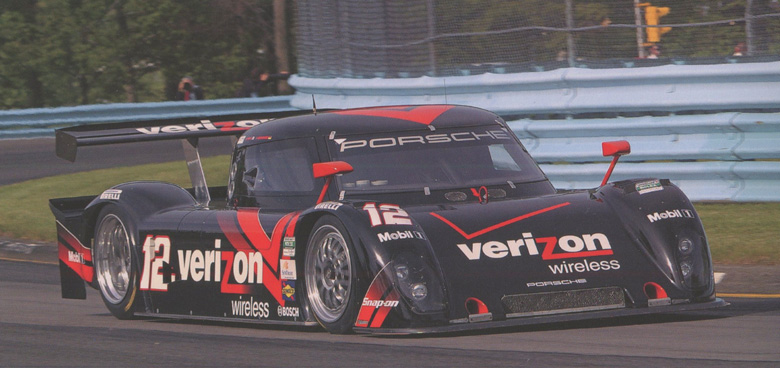
2009, Watkins Glen. The Penske Verizon Riley Porsche was one of 12 Riley chassis completing in the event!
Finally, he puts us on to the single seat race cars powered by Porsche, with details about the various and unsuccessful Indy attempts, and a look at the TAG Porsche F1 engines. Another chapter charts the boats, tractors and airplanes that also used Porsche power. Nothing missed here!
Powered by Porsche is a wonderful and impressive book. Although there are no footnotes as such, all major sources are attributed throughout the book within the text. There is a good index, bibliography, and perhaps the nicest feature is list of all the cars with chapter references upfront. Absolutely essential for the serious Porsche enthusiast, and a true education for the rest of us.
Powered by Porsche – the alternative race cars
Hardback • 25x25cm • 464 pages • 750 pictures
ISBN: 978-1-845849-90-0
Order here
Price: 100.00 GBP=134.715 USD
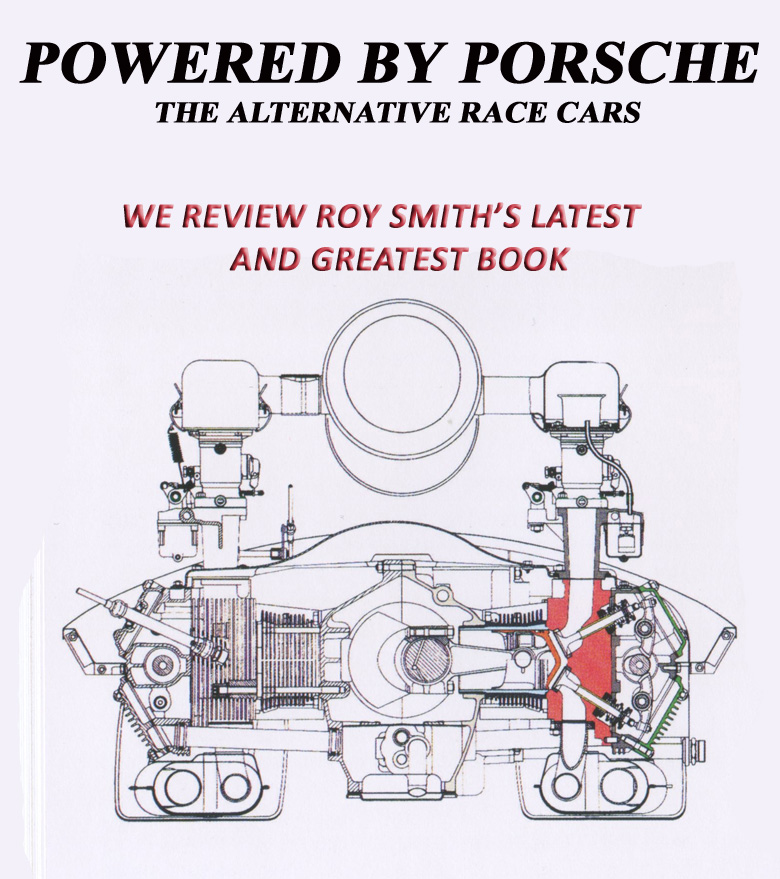
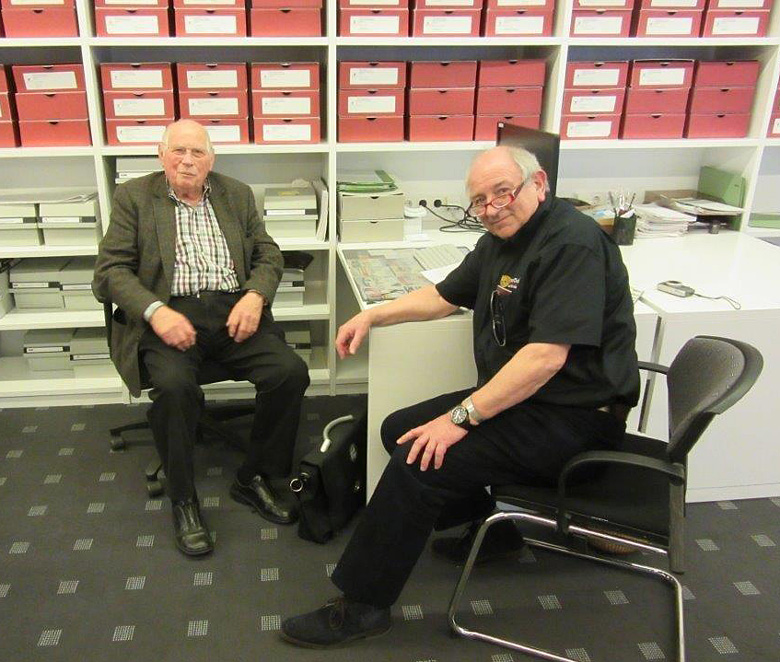
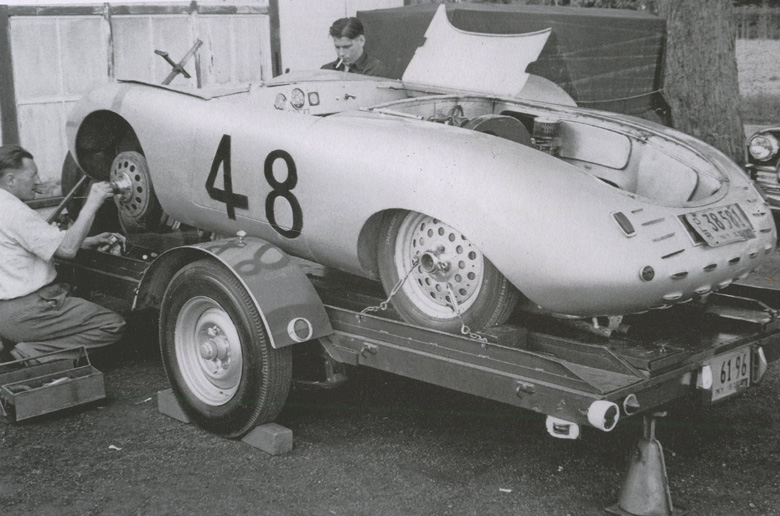
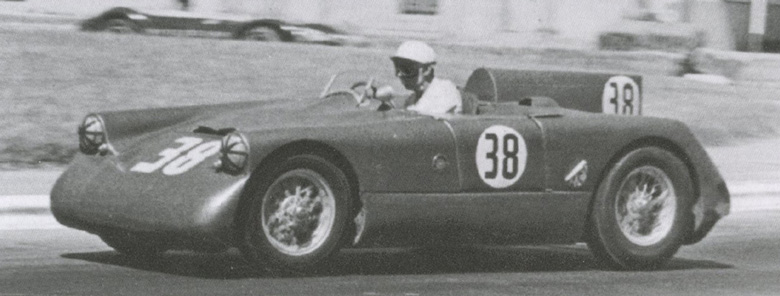
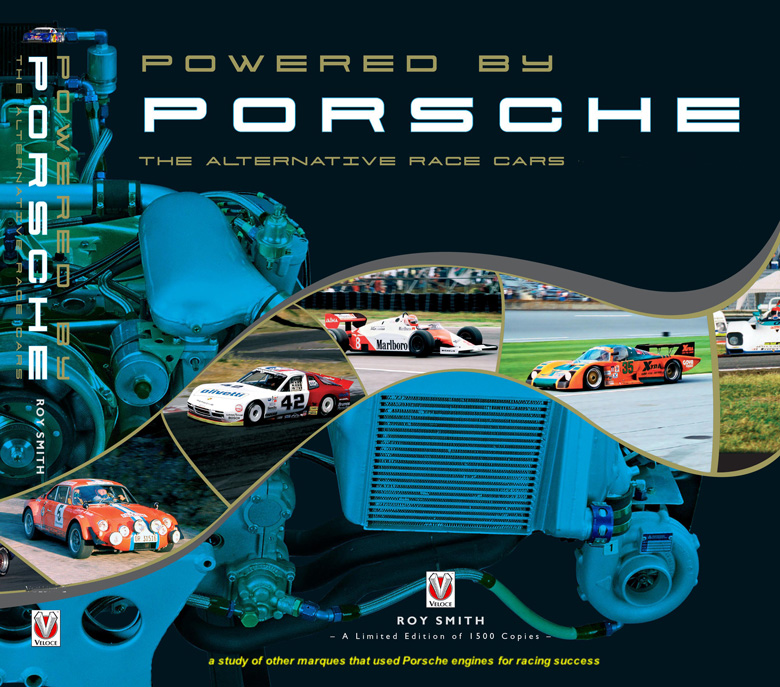
Car driven by frtiend Jack Mc Afee was NOT Monaco
butr the old Cooper bobtaIL OF 1100cc SIZE
AND THEN BUILT BY kKn MILES WHEN
WORKING FOR JOHN VON NEUMANN
cAR RACED BY himswlf 3 TIMES BY MILES
THEN TOLD BY PORSCHWE TO STOP USING IT,
jIM SITZ
Amazing Post, Pete, Congratulations!
Keep up Showing asMotor car Rracing of a Golden Era!
Best, Carlos Alvim!